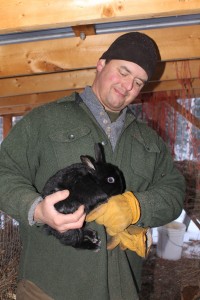Copper Kettle Farm is home to reindeer and rabbits
December 20, 2011
907-474-5042
12/20/11
For Two Rivers farmer Darren Demattio, building proper infrastructure is imperative for a successful agricultural venture.
Six years ago, he started clearing the virgin forest on his 319-acre farm. The progress he and his wife Cristina have made since then is amazing. The couple’s Copper Kettle Farm, 25 mile Chena Hot Springs Road, features fields and fencing, two greenhouses and shelter for rabbits and chickens.
“We’re trying to get things running smoothly and get the bumps and wiggles figured out,” Demattio said. “Things are going well; God has blessed us.”
Growing up in eastern Ohio, Demattio, 45, was so infatuated with farming that he spent every spare minute doodling pictures of what his future farm would look like. He served in the Army for three years and then became a surveyor in Nevada. He came to Fairbanks to help set up Fort Knox, where he was a surveyor for 13 years. “Farming has always been my dream,” he said. “Now it’s come to fruition.”
He is one of the few reindeer producers in the Interior, with 10 beautiful animals. Three years ago, Demattio and a friend went to Canada to buy reindeer because in Alaska only Natives are allowed by law to own Alaska reindeer. “My biggest challenge is growing the reindeer herd and I’m not going back to Canada,” Demattio said. He bought five reindeer there.
Reindeer, Demattio declares, are the perfect animal for Alaska because they are so suited to the environment. “They live on willow and birch,” he said. Their diet also includes barley, a pellet mix, wheatgrass, bluegrass and Timothy.
Originally, Demattio intended to raise Galloway cattle and he may yet add some to the farm, but it was the resistance to disease that pulled him to the reindeer. He has learned to be patient with the animals, for they have a sensitive side. Each reindeer has its own special personality. Some sidle up to him for attention when he enters their enclosure, others prefer to keep their distance. “Each one has a different attitude,” Demattio said. “I just accept them.” One even has a “movie star” career behind her, having been in the movie “Elf.”
One of his goals is to train one of the deer to pull a sled just like a dog team does.
A surprise for Demattio has been that half of what he had read about reindeer was erroneous. He advises others interested in raising reindeer to build their infrastructure first and not to jump the gun and run to Canada. “The paperwork is astounding,” he said of the process to import the animals to Alaska.
But farming in general is something he encourages others to try. “Don’t let people who’ve been farming a while tell you it can’t work,” he said. Count on calluses and sore muscles too. “If you’re going to do something like this you’re going to have to be ready to work,” he said. Lamenting that Americans are too hung up on leisure time, Demattio said the work on a farm can be daunting, “but you kick through it.” He praised his wife, a DOT engineer, for her work ethic and said he couldn’t make the farm successful without her. “We have a common goal,” he said.

It’s obvious in the corral with Demattio and the reindeer that he is very fond of his herd. He envisions it growing to 100 but has to figure out how to make that happen since there isn’t a diverse stock for breeding.
“They are the winning ticket for Alaska agriculture,” he said. He has been extremely impressed with the health of the animals. “I have had no vet bills in three years,” he said, crediting the natural diet he has them on.
“One of the biggest challenges to Alaska agriculture is people don’t think about sustainable profit versus maximum profit for a short period of time,” he said.
While he grows the reindeer herd, Demattio has found rabbits to be a valuable food source for his family. He praised the merits of the California rabbit and said the children will eat all the rabbit put on their plates. “Rabbits are the perfect homestead animal, bar none,” he said. Chickens are another important part of the farm, as are the vegetables produced in the greenhouses. Demattio grows enough cucumbers, tomatoes, carrots, beans, peas and honeydew melons to feed the family and sells the excess to friends and neighbors.
In the end it is his three children Demattio is farming for. “They’re my real crop,” he said. “My long-term goal is to see my kids take over the farm.”
This column is provided as a service by the UAF School of Natural Resources and Agricultural Sciences and the Agricultural and Forestry Experiment Station.


